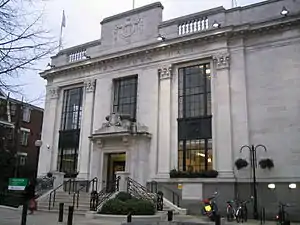London Borough of Islington | |
|---|---|
 Coat of arms  Council logo | |
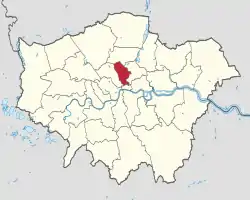 Islington shown within Greater London | |
| Sovereign state | United Kingdom |
| Constituent country | England |
| Region | London |
| Ceremonial county | Greater London |
| Created | 1 April 1965 |
| Admin HQ | Islington Town Hall, Upper Street, Islington |
| Government | |
| • Type | London borough council |
| • Body | Islington London Borough Council |
| • Leadership | Leader & Cabinet (Labour) |
| • Mayor | Cllr Gary Heather[1] |
| • London Assembly | Sem Moema (Labour) AM for North East |
| • MPs | Jeremy Corbyn (Independent) Emily Thornberry (Labour) |
| • Council Leader | Cllr Kaya Comer-Schwartz (Labour) |
| Area | |
| • Total | 5.74 sq mi (14.86 km2) |
| • Rank | 294th (of 296) |
| Population (2021) | |
| • Total | 216,767 |
| • Rank | 86th (of 296) |
| • Density | 38,000/sq mi (15,000/km2) |
| Time zone | UTC (GMT) |
| • Summer (DST) | UTC+1 (BST) |
| Postcodes | |
| Area code | 020 |
| ONS code | 00AU |
| GSS code | E09000019 |
| Police | Metropolitan Police |
| Website | https://www.islington.gov.uk/ |
The London Borough of Islington (/ˈɪzlɪŋtən/ ⓘ IZ-ling-tən) is a London borough which forms part of Inner London, England. Islington has an estimated population of 215,667. It was formed in 1965, under the London Government Act 1963, by the amalgamation of the metropolitan boroughs of Islington and Finsbury.[2]
The new entity remains the second smallest borough in London and the third-smallest district in England. The borough contains two Westminster parliamentary constituencies; Islington North, represented by former Labour Party leader Jeremy Corbyn, and Islington South & Finsbury represented by Labour MP Emily Thornberry. The local authority is Islington Council. The borough is home to football club Arsenal, one of the premier league clubs in England, and its home Emirates Stadium.
Etymology
Islington was originally named by the Saxons Giseldone (1005), then Gislandune (1062). The name means 'Gīsla's hill' from the Old English personal name Gīsla and dun 'hill', 'down'. The name then later mutated to Isledon, which remained in use well into the 17th century when the modern form arose.[3] In medieval times, Islington was just one of many small manors in the area, along with Bernersbury, Neweton Berewe or Hey-bury, and Canonesbury (Barnsbury, Highbury and Canonbury – names first recorded in the 13th and 14th centuries). "Islington" came to be applied as the name for the parish covering these villages and was the name chosen for the Metropolitan Borough of Islington on its formation in 1899. On the merger with Finsbury to form the modern borough, this name came to be applied to the whole borough.
Geography
The southern part of the borough, south of the A501 Pentonville Road and City Road, forms part of the central London congestion charging zone and the Ultra Low Emission Zone. A significant part of the southern section of the borough borders the City of London, with the area to the west bordering the London Borough of Camden. The central London area includes Farringdon and Old Street stations both in Zone 1.
Districts
The borough includes the areas:
- Angel
- Archway
- Barnsbury
- Canonbury
- Clerkenwell
- Farringdon
- Finsbury
- Finsbury Park (split between three boroughs. Other boroughs are London Borough of Haringey and London Borough of Hackney).
- Highbury
- Highgate
- Holloway
- Islington
- Kings Cross
- Lower Holloway
- Mildmay
- Nag's Head
- Newington Green
- Old Street
- Pentonville
- St Luke's
- Tufnell Park
- Upper Holloway
Wards
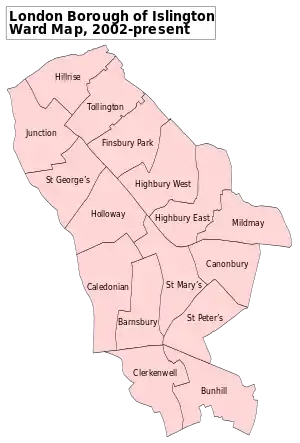
- Barnsbury
- Bunhill
- Caledonian
- Canonbury
- Clerkenwell
- Finsbury Park
- Highbury East
- Highbury West
- Hillrise
- Holloway
- Junction (part of Archway and Upper Holloway)
- Mildmay
- Saint George's
- Saint Mary's (covering most of Upper Street)
- Saint Peter's
- Tollington
Governance
Islington London Borough Council
Islington Council is the borough's local authority. It is a London borough council, one of thirty-two principal subdivisions of the administrative area of Greater London. The council was created by the London Government Act 1963 and replaced two local authorities: Finsbury Metropolitan Borough Council and Islington Metropolitan Borough Council. The former Islington Metropolitan Town Hall, at the intersection of Upper Street and Richmond Grove, serves as the present Borough's council building.[4]
Islington is divided into 17 wards, each electing three councillors.[5] Following the May 2022 election, Islington Council comprises 48 Labour Party councillors and 3 Green Party councillors. Of these 51 councillors, the Leader of the council is Councillor Kaya Comer-Schwartz and Councillor Caroline Russell is the leader of the Green opposition group.[6][7]
UK Parliament
Islington is represented by two parliamentary constituencies. Islington North is represented by Jeremy Corbyn, formerly of the Labour Party, who was the Leader of Her Majesty's Opposition between 2015 and 2020. Islington South and Finsbury is represented by Emily Thornberry, former Shadow First Secretary of State and Shadow Secretary of State for Foreign and Commonwealth Affairs and current Shadow Secretary of State for International Trade of the Labour Party.
Greater London representation
For elections to the Greater London Council, the borough formed the Islington electoral division, electing three members. In 1973 it was divided into the single-member Islington Central, Islington North and Islington South and Finsbury electoral divisions.[8] The Greater London Council was abolished in 1986.
Since 2000, for elections to the London Assembly, the borough forms part of the North East constituency.
Economy
In the Victorian Age, some parts of Islington such as Clerkenwell were known for their poverty, which George Gissing describes in his naturalist novel, The Nether World (1889).
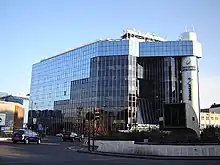
Major public and private bodies
Prisons
There is one prison in Islington, a men's prison, HM Prison Pentonville. Until it closed in 2016 there was also a women's prison HM Prison Holloway, which in the early 20th century was used to hold many suffragettes.
Transport
The Borough boasts a large transport network for rail, bus, cycles and road users.
London Underground
There are ten London Underground stations in the borough across London fare zones 1, 2 and 3. These stations are principally served by the Northern, Piccadilly and Victoria lines, although the Circle, Hammersmith & City and Metropolitan lines also pass through the Borough:
- Angel
.svg.png.webp)
- Archway
.svg.png.webp)
- Arsenal
.svg.png.webp)
- Caledonian Road
.svg.png.webp)
- Farringdon
.svg.png.webp)
.svg.png.webp)
.svg.png.webp)
.svg.png.webp)

- Finsbury Park
.svg.png.webp)
.svg.png.webp)

- Highbury & Islington
.svg.png.webp)
.svg.png.webp)

- Holloway Road
.svg.png.webp)
- Old Street
.svg.png.webp)

- Tufnell Park
.svg.png.webp)
The Piccadilly line carries passengers to key London destinations, including the West End and Heathrow Airport (![]() ). The Northern and Victoria lines also link the Borough to the West End, whilst the Northern line (Bank Branch) also passes through the City of London.
). The Northern and Victoria lines also link the Borough to the West End, whilst the Northern line (Bank Branch) also passes through the City of London.
Just beyond the Borough's borders are King's Cross St Pancras (in the London Borough of Camden) and Moorgate (in the city).
London Overground
There are also several London Overground stations in the borough, all but one of which are in London fare zone 2:
National Rail
There are several other National Rail stations in Islington, which offer direct services to destinations across London, East Anglia and South East England:
Farringdon and Finsbury Park are served by Thameslink services, with some trains travelling direct to Gatwick Airport (![]() ), as well as destinations including Cambridge, Peterborough, Brighton and Sevenoaks. Other stations, including Finsbury Park, are served by Great Northern trains which normally operate between Moorgate and Welwyn Garden City. The Elizabeth line calls at Farringdon.
), as well as destinations including Cambridge, Peterborough, Brighton and Sevenoaks. Other stations, including Finsbury Park, are served by Great Northern trains which normally operate between Moorgate and Welwyn Garden City. The Elizabeth line calls at Farringdon.
Moorgate lies just to the south of the Borough, in the City of London, whilst King's Cross lies to the Borough's immediate west, with destinations including Sheffield, Leeds, Newcastle, Edinburgh and Inverness.
Travel to work
In March 2011, the main forms of transport that residents used to travel to work were: underground, metro, light rail, tram, 19.4% of all residents aged 16–74; bus, minibus or coach, 10.3%; on foot, 10.3%; bicycle, 6.2%; driving a car or van, 6.0%; train, 3.7%; work mainly at or from home, 3.6%.[10]
Attractions and institutions
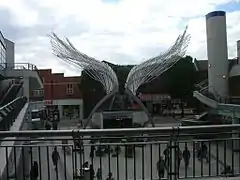
- Almeida Theatre
- Angel Central shopping centre (formerly the Islington N1 Centre), containing:
- O2 Academy Islington
- Vue cinema
- Artillery Ground
- Pleasance Islington theatre
- Courtyard Theatre
- Emirates Stadium (and the former Arsenal Stadium at Highbury)
- The Estorick Collection of Modern Italian Art in Canonbury Square
- Freightliners City Farm
- Hen and Chickens Theatre
- Islington Arts Factory, in Parkhurst Road
- Islington Local History Centre, located at Finsbury Library
- Islington Museum, located at Finsbury Library
- John Salt, cocktail bar on Upper Street
- The King's Head Theatre
- Little Angel Theatre a puppet theatre and producer of the Suspense Puppetry Festival of London
- London Canal Museum, located in New Wharf Road, King's Cross
- London Charterhouse
- London Screen Academy, on Highbury Grove - specialist film/TV sixth form academy
- Odeon Cinema, located on Holloway Road
- Peter Benenson House, headquarters of Amnesty International
- Sadler's Wells Theatre
- St John's Gate, Clerkenwell (Islington's badge for London2012)
- The Screen On The Green, a single screen cinema on Upper Street
- Union Chapel
- Wesley's Chapel
Demographics
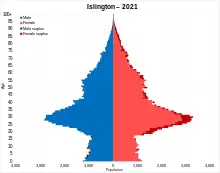
| Year | Pop. | ±% |
|---|---|---|
| 1801 | 65,721 | — |
| 1811 | 83,679 | +27.3% |
| 1821 | 108,333 | +29.5% |
| 1831 | 137,271 | +26.7% |
| 1841 | 162,717 | +18.5% |
| 1851 | 214,090 | +31.6% |
| 1861 | 266,010 | +24.3% |
| 1871 | 317,930 | +19.5% |
| 1881 | 369,850 | +16.3% |
| 1891 | 397,799 | +7.6% |
| 1901 | 405,301 | +1.9% |
| 1911 | 412,944 | +1.9% |
| 1921 | 401,054 | −2.9% |
| 1931 | 389,513 | −2.9% |
| 1941 | 324,143 | −16.8% |
| 1951 | 269,743 | −16.8% |
| 1961 | 232,258 | −13.9% |
| 1971 | 200,022 | −13.9% |
| 1981 | 157,512 | −21.3% |
| 1991 | 173,384 | +10.1% |
| 2001 | 175,787 | +1.4% |
| 2011 | 206,125 | +17.3% |
| 2013 | 215,667 | +4.6% |
| Source: A Vision of Britain through time | ||
In 1801, the civil parishes that form the modern borough had a total population of 65,721. This rose steadily throughout the 19th century, as the district became built up; exceeding 200,000 in the middle of the century. When the railways arrived the rate of population growth increased—reaching nearly 400,000 by the turn of the century; with the Metropolitan Borough of Finsbury particularly suffering deprivation, poverty and severe overcrowding. The increase in population peaked before World War I, falling slowly in the aftermath until World War II began an exodus from London towards the new towns under the Abercrombie Plan for London (1944). The decline in population reversed in the 1980s, but it remains below its 1951 level.
According to the 2001 census Islington had a population of 175,797. It was 75% White, including 5% White Irish, 6% Black African, 5% Black Caribbean and 2% Bangladeshi. Thirty-two per cent of the borough's residents were owner–occupiers.
According to the 2011 census, Islington has the highest population density of local authorities in England and Wales—13,875 people per square kilometre.[11]
Islington has the second highest proportion of Irish people in the country, behind London Borough of Brent.[12]
A 2017 study by Trust for London and the New Policy Institute found that a third of Islington residents live in poverty. This is above the London average of 27%. It also found that just 14% of local employees are in jobs which pay below the London Living Wage - which is the 4th lowest figure of any London borough.[13]
39% of the borough are Christian, 12.8% Muslim, 1.7% are Jewish and 42.7% have no religion.[14] Christians and Muslims live throughout the borough, while the Jewish population is highest in the north of the borough in the Hillrise and Junction wards (bordering Highgate and Crouch End).
Ethnicity

The following table shows the ethnic group of respondents in the 2001, 2011 and 2021 census in Islington.
| Ethnic Group | 1981 estimations[15] | 1991[16] | 2001[17] | 2011[18] | 2021[19] | |||||
|---|---|---|---|---|---|---|---|---|---|---|
| Number | % | Number | % | Number | % | Number | % | Number | % | |
| White: Total | 128,093 | 83.1% | 133,601 | 81.12% | 132,464 | 75.35% | 140,515 | 68.17% | 134,754 | 62.1% |
| White: British | – | – | – | – | 99,784 | 56.76% | 98,322 | 47.70% | 86,092 | 39.7% |
| White: Irish | – | – | – | – | 10,057 | 5.72% | 8,140 | 3.95% | 7,062 | 3.3% |
| White: Gypsy or Irish Traveller | – | – | – | – | – | – | 163 | 0.08% | 108 | 0.0% |
| White: Roma | – | – | – | – | – | – | – | – | 958 | 0.4% |
| White: Other | – | – | – | – | 22,623 | 12.87% | 33,890 | 16.44% | 40,534 | 18.7% |
| Asian or Asian British: Total | – | – | 10,199 | 6.2% | 12,558 | 7.14% | 19,034 | 9.23% | 21,532 | 10.1% |
| Asian or Asian British: Indian | – | – | 2,424 | 1.5% | 2,851 | 1.32% | 3,534 | 2.06% | 4,051 | 1.9% |
| Asian or Asian British: Pakistani | – | – | 615 | 0.4% | 912 | 0.52% | 951 | 0.46% | 995 | 0.5% |
| Asian or Asian British: Bangladeshi | – | – | 2,695 | 1.6% | 4,229 | 2.41% | 4,662 | 2.26% | 5,972 | 2.8% |
| Asian or Asian British: Chinese | – | – | 2,141 | 1.3% | 3,074 | 1.75% | 4,457 | 2.16% | 5,125 | 2.4% |
| Asian or Asian British: Other Asian | – | – | 2,324 | 1.4% | 1,492 | 0.85% | 5,430 | 2.63% | 5,389 | 2.5% |
| Black or Black British: Total | – | – | 17,446 | 10.6% | 20,856 | 11.86% | 26,294 | 12.76% | 28,743 | 13.3% |
| Black or Black British: African | – | – | 6,009 | 3.6% | 10,500 | 5.97% | 12,622 | 6.12% | 18,091 | 8.4% |
| Black or Black British: Caribbean | – | – | 8,320 | 5.1% | 8,550 | 4.86% | 7,943 | 3.85% | 7,368 | 3.4% |
| Black or Black British: Other Black | – | – | 3,117 | 1.9% | 1,806 | 1.03% | 5,729 | 2.78% | 3,284 | 1.5% |
| Mixed or British Mixed: Total | – | – | – | – | 7,234 | 4.11% | 13,339 | 6.47% | 16,231 | 7.4% |
| Mixed: White and Black Caribbean | – | – | – | – | 2,329 | 1.32% | 4,236 | 2.06% | 4,171 | 1.9% |
| Mixed: White and Black African | – | – | – | – | 1,241 | 0.71% | 1,912 | 0.93% | 2,257 | 1.0% |
| Mixed: White and Asian | – | – | – | – | 1,543 | 0.88% | 2,964 | 1.44% | 3,750 | 1.7% |
| Mixed: Other Mixed | – | – | – | – | 2,121 | 1.21% | 4,227 | 2.05% | 6,053 | 2.8% |
| Other: Total | – | – | – | – | 2,685 | 1.53% | 6,943 | 3.37% | 15,330 | 7.1% |
| Other: Arab | – | – | – | – | – | – | 1,893 | 0.92% | 2,991 | 1.4% |
| Other: Any other ethnic group | – | – | 3,440 | 2.1% | 2,685 | 1.53% | 5,050 | 2.45% | 12,339 | 5.7% |
| Ethnic minority: Total | 26,044 | 16.9% | 31,085 | 18.87% | 43,333 | 24.65% | 65,610 | 31.83% | 81,836 | 37.9% |
| Total | 154,137 | 100% | 164,686 | 100% | 175,797 | 100.00% | 206,125 | 100.00% | 216,590 | 100% |
Religion
The following shows the religious identity of residents residing in Islington according to the 2001, 2011 and the 2021 censuses.
| Religion | 2001[20] | 2011[21] | 2021[22] | |||
|---|---|---|---|---|---|---|
| Number | % | Number | % | Number | % | |
| Holds religious beliefs | 116,310 | 66.2 | 110,076 | 53.4 | 111,222 | 51.4 |
| Christian | 95,305 | 54.2 | 82,879 | 40.2 | 75,129 | 34.7 |
| Muslim | 14,259 | 8.1 | 19,521 | 9.5 | 25,840 | 11.9 |
| Sikh | 590 | 0.3 | 569 | 0.3 | 603 | 0.3 |
| Hindu | 1,751 | 1.0 | 2,108 | 1.0 | 2,195 | 1.0 |
| Buddhist | 1,840 | 1.0 | 2,117 | 1.0 | 1,813 | 0.8 |
| Jewish | 1,846 | 1.1 | 1,915 | 0.9 | 2,714 | 1.3 |
| Other religion | 719 | 0.4 | 967 | 0.5 | 2,930 | 1.4 |
| No religion | 41,691 | 23.7 | 61,911 | 30.0 | 88,466 | 40.8 |
| Religion not stated | 17,796 | 10.1 | 34,138 | 16.6 | 16,902 | 7.8 |
| Total population | 175,797 | 100.0 | 206,125 | 100.0 | 216,590 | 100.0 |
Education
Universities
The London Borough of Islington is home to two higher education institutions:
- City, University of London at Northampton Square, formerly The City University, founded in 1894 as the Northampton Institute; and
- London Metropolitan University, North Campus on the Holloway Road, formed from the merger of the University of North London and London Guildhall University in 2002; the University of North London was founded on this site in 1896 as the Northern Polytechnic Institute
Moorfields Eye Hospital is a major centre for postgraduate training of ophthalmologists, orthoptists, optometrists, and nurses.
Further Education
The borough also currently contains three colleges of further education:
- London Screen Academy; (a sixth form academy set up by Working Title Films to train young people in behind the camera skills)
- City and Islington College
- Westminster Kingsway College (while major improvement works are carried out at King's Cross)
There are two performing arts colleges. The Urdang Academy and the Musical Theatre Academy are both based in Islington.
Schools
The borough currently maintains 47 primary schools, 10 secondary schools, three special schools and five Pupil Referral Units. In 2000, Cambridge Education Associates, a private firm, took over the management of the Islington's state schools from the local education authority.[23]
Media
The Islington Gazette is a local newspaper.
Freedom of the Borough
The following people and military units have received the Freedom of the Borough of Islington.
Individuals
- Arsène Wenger: 2004[24]
Military units
- The Honourable Artillery Company, October 2009[25]
- The Islington Veterans' Association, March 2015[26]
- The Islington and Holloway fire stations of the London Fire Brigade, March 2018[27]
See also
References
- ↑ "The Mayor of Islington". Islington Council.
- ↑ "London Government Act 1963". Legislation.gov.uk. Retrieved 26 March 2021.
- ↑ 'Islington: Growth', A History of the County of Middlesex: Volume 8: Islington and Stoke Newington parishes. 1985. pp. 9–19. Retrieved 13 March 2007.
- ↑ "Islington Town Hall". Islington Council. Retrieved 22 July 2014.
- ↑ "Councillors and Wards". Archived from the original on 9 October 2010. Retrieved 16 October 2010.
- ↑ "Members of Islington Council". Islington Council. Retrieved 22 July 2014.
- ↑ "Your Councillors". Islington Council. Retrieved 25 December 2018.
- ↑ Boothroyd, David. "Greater London Council Election results: Islington". United Kingdom Election Results. Archived from the original on 24 March 2016. Retrieved 17 September 2023.
- ↑ "Privacy Policy." Inmarsat. Retrieved on 26 March 2014. "99 City Road London EC1Y 1AX United Kingdom"
- ↑ "2011 Census: QS701EW Method of travel to work, local authorities in England and Wales". Office for National Statistics. Retrieved 23 November 2013. Percentages are of all residents aged 16-74 including those not in employment. Respondents could only pick one mode, specified as the journey's longest part by distance.
- ↑ "2011 Census - Population and Household Estimates for England and Wales, March 2011" (PDF). webarchive.nationalarchives.gov.uk. Archived (PDF) from the original on 16 July 2012. Retrieved 3 October 2022.
- ↑
- ↑ "Poverty and Inequality Data For Islington - Trust For London". Trust for London. Retrieved 3 October 2022.
- ↑ "Population by Religion, Borough". Data.london.gov.uk. Retrieved 24 January 2023.
- ↑ "Ethnic minorities in Britain: statistical information on the pattern of settlement". Commission for Racial Equality: Table 2.2. 1985.
- ↑ "1991 census – theme tables". NOMIS. Retrieved 20 January 2017.
- ↑ "KS006 - Ethnic group". NOMIS. Retrieved 30 January 2016.
- ↑ "Ethnic Group by measures". NOMIS. Retrieved 8 January 2016.
- ↑ "Ethnic group - Office for National Statistics". Ons.gov.uk. Retrieved 29 November 2022.
- ↑ "KS007 - Religion - Nomis - 2001". Nomisweb.co.uk. Retrieved 18 October 2022.
- ↑ "KS209EW (Religion) - Nomis - 2011". Nomisweb.co.uk. Retrieved 18 October 2022.
- ↑ "Religion - 2021 census". Office of National Statistics. 29 November 2022. Archived from the original on 29 November 2022. Retrieved 16 December 2022.
- ↑ "BBC News | EDUCATION | Islington schools: is privatisation working?". News.bbc.co.uk.
- ↑ "Arsenal to get a place on the political map". Camden New Journal. Retrieved 3 October 2022.
- ↑ "The HAC receiving the Freedom of the Borough of Islington". Reserve Forces and Cadets Association for Greater London. 1 October 2009. Archived from the original on 10 September 2012.
- ↑ Brigstock-Barron, Rory (20 March 2015). "Former councillor and veterans given freedom of Islington". Islingtongazette.co.uk.
- ↑ Drew, Rosie (5 July 2017). "Freedom of the borough for Islington and Holloway's firefighters". Islingtongazette.co.uk.
